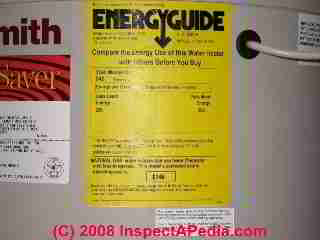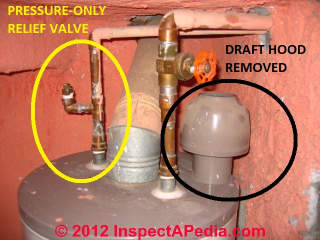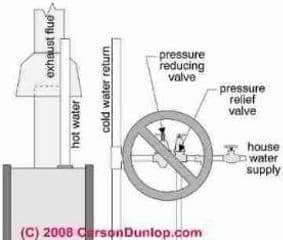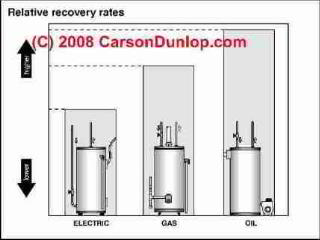 Guide to Characteristics of Types of Hot Water Heaters
Guide to Characteristics of Types of Hot Water Heaters
- POST a QUESTION or COMMENT about the properties, costs, efficiencies, and performance of different types of residential hot water heating systems
Hot water heater properties - water heater cylinders:
This article describes how to compare the operating characteristics such as safety, capacity, life expectancy, and operating cost of alternative methods of providing domestic hot water for washing and bathing.
Discussed here: Comparison of the costs of different types of hot water heaters: operating cost, maintenance cost, purchase cost. Comparison of the hot water production capacities of different types of water heaters: hot water quantity, hot water recovery rates. Comparison of different water heating methods regarding water heater safety.
How to compare various features of hot water heating methods: electric, gas, high efficiency gas, oil, high efficiency oil, solar, tankless coils, etc.
InspectAPedia tolerates no conflicts of interest. We have no relationship with advertisers, products, or services discussed at this website.
- Daniel Friedman, Publisher/Editor/Author - See WHO ARE WE?
A Comparison of the Properties of Types of Hot Water Heaters
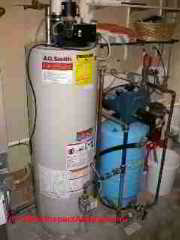 Thanks to Carson Dunlop Associates, a Toronto Home Inspection Firm and Home Inspection Educator, for permission to use sketches shown in this article.
Thanks to Carson Dunlop Associates, a Toronto Home Inspection Firm and Home Inspection Educator, for permission to use sketches shown in this article.
Article contents:
- WATER HEATER COMPARISONS, PROPERTIES - This article on water heater characteristics describes and compares the following properties of different kinds of water heating systems and appliances:
- WATER HEATER LIFE EXPECTANCY COMPARISONS
- WATER HEATER OPERATING COST COMPARISONS
- WATER HEATER PURCHASE & MAINTENANCE COSTS
- WATER HEATER WATER QUANTITY COMPARISONS
- WATER HEATER RECOVERY SPEED COMPARISONS
- WATER HEATER SAFETY COMPARISONS
- WATER HEATER EFFICIENCY factor ratings - separate article
- WATER HEATER LIFE - separate article
- TANKLESS WATER HEATER LIFE & USES - separate article
Ways to improve total hot water quantity, pressure, temperature and flow are discussed beginning at HOT WATER IMPROVEMENTS
The following individual water heater type articles discuss alternative ways to produce domestic hot water for washing and bathing.
- HIGH EFFICIENCY WATER HEATERS such as direct-vent gas-fired water heaters
- INDIRECT-FIRED WATER HEATERS which use a separate heating boiler to produce a larger quantity of hot water
- INSTANTANEOUS WATER HEATERS point of use systems that have little or no standby energy losses
- MULTIPLE WATER HEATERS IN PARALLEL to increase total hot water quantity
- MULTIPLE WATER HEATERS IN SERIES to stage hot water heating for varying levels of demand
- RANGE BOILER WATER HEATER an older form of indirect-fired hot water heating used with separate heating boilers
- SIDE ARM COIL WATER HEATER similar to instantaneous and tankless coil water heaters, often used with range boilers
- SOLAR WATER HEATERS using solar collectors, an indoor water tank, pump and controls, using minimal "on-grid" energy
- TANKLESS COIL HOT WATER INCREASE a heat exchanging coil immersed inside of a heating boiler heats provides (somewhat limited) hot water. various tricks can significantly improve the safety and water quantity available
Water heater life expectancy, cost, safety, and capacity are also discussed
at WATER HEATER PROBLEM DIAGNOSIS
A Comparison of the Relative Life Expectancy of Different Types of Water Heaters
Here is a rough guess at the relative life expectancy of these types of water heaters, provided all other water heater life factors (discussed at AGE of WATER HEATERS) are the same - water heaters are listed in their order of typical life from shortest to longest:
- Electric water heaters (though individual heating elements may fail and need to be replaced before the tank fails)
- ELECTRIC WATER HEATERS - Gas-fired water heaters, High Efficiency Models (LP gas or natural gas)
- GAS HEATERS, HIGH EFFICIENCY - Gas-fired water heaters (LP gas or natural gas)
- GAS FIRED WATER HEATERS - Oil-fired water heaters
- OIL FIRED WATER HEATERS - Solar water heaters have a relatively high purchase cost but probably lower maintenance cost than oil and gas fired equipment
- SOLAR HOT WATER HEATERS
Conditions Affecting Water Heater Life
Keep in mind that conditions besides the type of water heater can dominate its life expectancy. Some of these water heater life expectancy factors include the following examples:
- The duty cycle or level of usage of the water heater (more use = shorter life)
- The chemistry of the water being heated (aggressive or corrosive water = shorter life)
- The construction of the water tank,
methods and materials used (look at the water heater warranty period; longer warranty probably means a more durable water heater tank) - Proper installation
of the water heater; improper fuel or water piping connections or inadequate chimney venting on fossil-fuel fired water heaters can lead to safety problems or leaks and early heater failure. Improper location or improper position of the water heater (such as mounting some water heaters horizontally) can lead to early failure of the heater as well as voiding the manufacturer's warranty. - Proper maintenance; almost no one we've encountered drains and services their water heater on the schedule recommended by the manufacturer
For complete information about water heater life and things that affect how long a hot water heater will last, see our full article
at WATER HEATER LIFE
How to Evaluate the Present and Future Relative Operating Cost of Different Types of Water Heaters: definition of therms
Heating fuel costs vary among different communities, states or provinces, and countries. In most of North America and in some of Europe it's more costly to heat water by electricity than oil and more costly to heat water by oil than gas.
However exceptions occur, especially where one or another energy source is regulated or subsidized by government, or where cheaper sources of electrical energy may be available such as in areas where hydro-electric plants are common.
Certainly, a modern high efficiency oil or gas water heater will cost less to operate than older models of water heater using the same fuel.
Compare the Energy Guide sticker data to compare the relative operating costs of alternative water heaters that you are considering. Our sample water heater energy guide sticker above provides the following data that you can compare among other water heater alternatives:
- Annual energy use measured in Therms per year
For example, our high efficiency AO Smith natural gas water heater shown
at HIGH EFFICIENCY WATER HEATERS uses an estimated 242 Therms/Year - Estimated annual operating cost in dollars.
The water heater we are using as an example has a (standardized) annual operating cost of $146.
Naturally this number is "wrong" in that the amount of hot water individual families will use varies among households, and the price of various energy sources (electric, gas, oil) is continuously increasing.
But this is the measurement we want: a stable number that permits comparison among alternative types of water heaters. - Where the particular water heater model falls in the whole range
of water heater annual energy usage rates. (Least energy usage = 220, most energy usage = 288), so you can see not only how your water heater compares with other models, but where your water heater falls in the energy efficiency range. - The energy efficiency factor ratings
for different water heater types are found
at WATER HEATER EFFICIENCY.
What is the Definition of a Water Heater Therm?
In the U.S. natural gas is sold to consumers sometimes measured in therms (th). Therms is also used in Energy Guide ratings useful for comparing alternative water heater operating costs.
A therm is the amount of natural gas used to generate 100,000 BTUs of energy.
A therm (th) is thus also a measure of heat content, or a measure of energy usage.
Since this is a simple fixed number, it's easy to compare gas-fired water heater efficiencies.
Example: If water heater A uses 1 therm to produce 100 gallons of hot water heated up from 40 degF to 120 degF, and water heater B uses 2 therms to produce the same 100 gallons of hot water heated up from 40 degF to 120 degF, then water heater A will cost half as much to operate as water heater B.
In other words, the fewer therms/gallon or therms/estimated-annual-usage-in-gallons, the higher is the efficiency and lower the operating cost of a given water heater.
Relative purchase and maintenance cost of water heaters
In order of cost from least-costly to most-costly to purchase and maintain we estimate this order of types of water heater:
- Electric water heaters (least costly to purchase and install)
- Gas-fired water heaters, High Efficiency Models (LP gas or natural gas)
- Gas-fired water heaters (LP gas or natural gas)
- Oil-fired water heaters
- Solar water heaters have a relatively high purchase cost but probably lower maintenance cost than oil and gas fired equipment
 Remember to Include Water Heating Method Conversion Costs When Changing Water Heaters
Remember to Include Water Heating Method Conversion Costs When Changing Water Heaters
Don't forget that if your plan to change the type of water heater, say from electric to oil or gas-fired, involves changing to use of a new fuel that you do not already have present at the property, extra costs will be involved to install the fuel tank, piping, and controls.
The new LP gas tank installed at this home where a gas fired water heater was installed to replace an electric unit added several hundred dollars to the installation cost.
Be sure to add those infrastructure costs as well as an estimate of the varying rates of change in energy prices among different fuels (electric, gas, oil, solar) into your analysis of the lifetime operating cost estimates when comparing alternative means of making domestic hot water.
Our opinion is that the only energy sources whose price is not going to increase in the coming decades are sources such as solar or wind energy.
It is plausible to expect the infrastructure of those systems may actually decline when more people begin to purchase them and their production volume increases.
Hot Water Quantity: A Comparison of the Relative Total Hot Water Capacity of Different Types of Water Heaters
Any water heating method that stores hot water in a tank will provide about the same total hot water capacity if the tank is the same size. This includes electric, gas, oil fired water heaters and side-arm coil water heaters or range boilers, all of which use a water storage tank.
Instantaneous water heaters, also called tankless water heaters, can provide effectively endless hot water but usually in limited quantity to the one or two fixtures supplied by the heater.
Tankless coils provide a more limited quantity of hot water, depending on the amount of heat stored in the heating boiler (a function of its size and materials of construction - steel has less heat storage than cast iron), the temperature of the incoming water, the use of mixing valves, and the flow rate through the coil.
Most tankless coils are rated as capable of providing a specific temperature degree rise across the coil, from input to output, at a specified boiler temperature and at a specified water flow rate in gallons per minute (often 5 gpm). If the water flow rate is faster than specified the coil will not heat water to as high a temperature.
Relative Hot Water Recovery Rate/Speed of Different Types of Water Heaters - What is the recovery rate of a water heater?
The hot water heater recovery speed of a water heating system refers to how quickly the water heater can re-heat incoming cold water.
The standard measure of domestic hot water heater recovery rate is the number of gallons of water than can be heated to 140 degF in one hour. (There must be an underlying assumed-temperature of the incoming water).
A water heater that has a recovery rate of 35 gph will make hot water faster than a water heater that has a recovery rate of only 20 gph.
On newer water heaters you'll see the water heater's recovery rate printed on one of the information labels affixed to the equipment. (Also see
Particularly if your water heater has limited total hot water quantity, and if you expect high hot water usage (such as a large family all wanting to take long hot showers one after another), the recovery speed of the water heater can be an important factor in evaluating its adequacy.
There is some subjectivity in this list.
We've encountered a large family of six who said they never ran out of hot water although they were all living in a home whose hot water was provided by a single tankless coil on an old heating boiler.
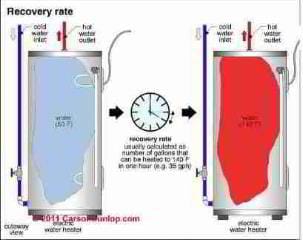 We've encountered a small family of two adults who complained that they never had enough hot water even though their home was served by a 40 gallon oil-fired water heater.
We've encountered a small family of two adults who complained that they never had enough hot water even though their home was served by a 40 gallon oil-fired water heater.
A lot depends on just how people use hot water: how much at once, how fast the flow, how long the flow per person, etc.
As we illustrate with Carson Dunlop Associates' sketches shown here, in order of speed of re-heating or hot water recovery time, listing slowest-recovery time to fastest recovery time we list water heater types as follows:
Water Heaters Ranked by Hot Water Recovery Speed or Time
Slowest to fastest:
- Range boilers (slowest recovery rate) -
RANGE BOILER WATER HEATER and also
SIDE ARM COIL WATER HEATER - Electric water heaters -
ELECTRIC WATER HEATERS also includes electric shower heaters - Gas-fired water heaters -
GAS FIRED WATER HEATERS - Gas-fired water heaters, High Efficiency Models -
HIGH-EFFICIENCY WATER HEATERS - Solar water heating systems (depends on weather, season, and sun exposure) -
SOLAR WATER HEATERS - Tankless coils (depends on heating boiler size, construction [steel/cast iron], thermal mass, and fuel type [oil/gas]) -
TANKLESS COIL HOT WATER INCREASE - Indirect-fired or tankless water heaters (depends on heating boiler size, construction [steel/cast iron], thermal mass, and fuel type [oil/gas]) -
INDIRECT-FIRED WATER HEATERS - Oil-fired water heaters -
OIL FIRED WATER HEATERS - Instantaneous water heaters -
INSTANTANEOUS WATER HEATERS
Don't confuse water heater recovery rates (how fast we can heat water) with water heater operating costs, which we discuss
at WATER HEATER OPERATING COST COMPARISON.
Recovery rate for a water heater or geyser is measured in gallons per hour or gph or in litres per hour or lph. Water heater operating costs are compared using a standard measure of energy cost in THERMS [definition].
A Comparison of the Relative Safety of Different Types of Water heaters
In the LP gas fired water heater shown in our photo, the installer had trouble fitting the draft hood atop the heater since there was then not enough overhead clearance to route the flue out of the building.
The installer has thoughtfully left the draft hood he removed, an important safety device, sitting atop the water heater as a reminder that this is an improper installation.
But in fact he could have been creating a fatal carbon monoxide hazard or a sooting problem in the water heater that could lead that heater to be unsafe.
There is just too much subjectivity to make a sensible answer to this question.
Really? We are not saying that all aspects of either fuel type heaters are equally risky or not.
In our OPINION each type of fuel has its advantages - both advantages and hazards differ between oil and LP or natural gas.
Examples of Hazard & Risk Differences between Oil & Gas Fired Heating Equipment
- Fuel explosion differences:
While it's difficult to set heating oil on fire and so explosions based on the fuel character may be less likely than with an LP or natural gas system, an oil-fired water heater runs at much higher burner and exhaust flue temperatures and so can present other types of fire risks.
Fuel oil fumes in a residential building are combustible but the fuel itself is difficult to ignite. Yet, a malfunctioning oil burner can lead to a dangerous puffback explosion.
An LP gas leak or natural gas leak in a building can lead to a catastrophic building explosion. - Operating temperature differences:
Fire clearance requirements are greater for oil fired heaters because their operating temperature range can be much higher, and in event of a malfunction, oil fired heater exhaust flue temperatures can exceed 500 degF.
Watch out: high stack temperatures, say over 500 °F and certainly over 600 °F probably mean that the heat exchanger in the boiler or furnace is soot-clogged, also risking a dangerous puffback explosion.
- Exhaust flue draft & CO Hazard differences:
The higher temperature of oil fired heaters improves the ability of the heater to establish adequate draft in its exhaust flue and chimney, especially in cold weather where an improperly-vented gas appliance may not develop enough draft and may spill exhaust gases into the building.
A malfunctioning gas burner can produce fatal carbon monoxide gas released into the occupied space.
Both of these are serious hazards, fortunately not occurring so often, but they're quite different.
In sum, both gas fueled (LP and natural gas) and heating oil fueled water heaters present various sorts of risk: fire, explosion, carbon monoxide, but the risks differ among these heater and fuel types.
Most critical in determining the safety of any water heater is that the heater is properly installed and includes the required safety controls such as those responsible for limiting temperature and pressure.
Any water heater should include a temperature and pressure relief valve installed of the proper type and at the correct location. Gas-fired devices also should include flue-gas spillage detectors. Oil-fired devices should also include a fire-safety valve that shuts off fuel to the appliance in case of fire.
We guess that proper installation, inspection, and maintenance make more difference in the safety of a water heater than the innate differences among heater types, fuels, etc.
Hot water heater safety devices and features
See our complete list of water heater safety features and devices found
at WATER HEATER SAFETY. Excerpts are below.
- Pressure/Temperature Relief Valves:
Water heaters (and any pressurized tank) require a pressure and temperature safety relief valve or TP valve as well as an extension or discharge tube.
We discuss the role of pressure/temperature relief valves in protecting against temperature and pressure explosion hazards
at RELIEF VALVE, WATER HEATER. - Spill switch on gas flues:
Gas fired water heaters should have a flue gas spillage switch that shuts off the gas valve if needed - Gas shutoff valves:
Gas fired water heaters in some jurisdictions require an automatic gas shutoff valve that responds to high water heater temperature. - Oil shutoff valves:
oil fired water heaters should always have their own oil safety valve: a special valve installed on the oil line near the water heater and which will automatically close and stop the flow of oil to the water heater should a fire occur.
Watch out: often in a building where there is an oil fired heating system as well as an oil fired water heater, the installer may have installed the safety valve only at the oil tank or only at the heating boiler or furnace. - Flame shields:
Gas or oil fired water heaters include a flame shield around the port used to inspect the burner - it must remain in place. - Combustion air:
any fossil fuel fired water heater (oil or gas fired) requires combustion air. The volume of air intake to the utility room where the heater is installed depends on the BTUs of the device and the type of fuel.
Watch out: installing a gas or oil fired heater in a small confined space whose door is shut and which lacks adequate combustion air is unsafe. - Combustion gas venting by a chimney: any fossil fuel fired water heater (oil or gas fired) requires safe venting of the combustion products, through a chimney or in the case of high efficiency heaters, through a plastic vent line. Watch out: venting a small gas fired water heater through a large old masonry chimney may be unsafe.
See CHIMNEYS for details. - Temperature settings: on the water heater,
setting the temperature very high in an attempt to obtain more hot water can be dangerous and lead to serious scalding burns for the building's occupants unless water tempering or mixing valves or other temperature safety controls are provided and properly set at the plumbing fixtures.
At a temperature setting of 100 degF or below most water heaters are unlikely to scald an occupant; more than 5 minutes exposure at 120 degF are required to produce 2nd & 3rd degree burns on adult skin.
Hot Water Scalding Burn Warning:
MIXING / ANTI-SCALD VALVES contains a table of hot water temperatures which are safe and which explains the risk of second and third degree scalding burns that occur at different water temperatures and exposure times.
Special thanks to InspectApedia.com reader muscabill@yahoo.com for questioning the clarity of some of the text in this article, 2023/10/11.
...
Continue reading at WATER HEATER ALTERNATIVES or select a topic from the closely-related articles below, or see the complete ARTICLE INDEX.
Or see these
Recommended Articles
- ANODES & DIP TUBES on WATER HEATERS
- HOT WATER IMPROVEMENTS - home
- WATER HEATER AGE & MANUALS - free PDF downloads of water heater IO Manuals
- WATER HEATER COMPARISONS, PROPERTIES
- WATER HEATER FLUSH PROCEDURE
- WATER HEATER LIFE
- WATER HEATER RESET BUTTONS & CONTROLS
- WATER HEATER OPERATING COST COMPARISON
Suggested citation for this web page
WATER HEATER COMPARISONS, PROPERTIES at InspectApedia.com - online encyclopedia of building & environmental inspection, testing, diagnosis, repair, & problem prevention advice.
Or see this
INDEX to RELATED ARTICLES: ARTICLE INDEX to WATER HEATERS
Or use the SEARCH BOX found below to Ask a Question or Search InspectApedia
Ask a Question or Search InspectApedia
Questions & answers or comments about the properties, costs, efficiencies, and performance of different types of residential hot water heating systems.
Try the search box just below, or if you prefer, post a question or comment in the Comments box below and we will respond promptly.
Search the InspectApedia website
Note: appearance of your Comment below may be delayed: if your comment contains an image, photograph, web link, or text that looks to the software as if it might be a web link, your posting will appear after it has been approved by a moderator. Apologies for the delay.
Only one image can be added per comment but you can post as many comments, and therefore images, as you like.
You will not receive a notification when a response to your question has been posted.
Please bookmark this page to make it easy for you to check back for our response.
IF above you see "Comment Form is loading comments..." then COMMENT BOX - countable.ca / bawkbox.com IS NOT WORKING.
In any case you are welcome to send an email directly to us at InspectApedia.com at editor@inspectApedia.com
We'll reply to you directly. Please help us help you by noting, in your email, the URL of the InspectApedia page where you wanted to comment.
Citations & References
In addition to any citations in the article above, a full list is available on request.
- Mark Cramer Inspection Services Mark Cramer, Tampa Florida, Mr. Cramer is a past president of ASHI, the American Society of Home Inspectors and is a Florida home inspector and home inspection educator. Mr. Cramer serves on the ASHI Home Inspection Standards. Contact Mark Cramer at: 727-595-4211 mark@BestTampaInspector.com
- John Cranor [Website: /www.house-whisperer.com ] is an ASHI member and a home inspector (The House Whisperer) is located in Glen Allen, VA 23060. He is also a contributor to InspectApedia.com in several technical areas such as plumbing and appliances (dryer vents). Contact Mr. Cranor at 804-873-8534 or by Email: johncranor@verizon.net
- Critique, contributions wanted: Contact Us to suggest text changes and additions and, if you wish, to receive online listing and credit for that contribution.
- A.O. Smith water heater safety sticker: 182734-000 Rev.00 observed on the gas fired water heater shown at High Efficiency Gas Water Heaters
- Carbon Monoxide Gas Toxicity, exposure limits, poisoning symptoms, and inspecting buildings for CO hazards
- Water Pressure Loss - Diagnosis how to determine why water pressure has been lost or why there is no water at all in a building
- In addition to citations & references found in this article, see the research citations given at the end of the related articles found at our suggested
CONTINUE READING or RECOMMENDED ARTICLES.
- Carson, Dunlop & Associates Ltd., 120 Carlton Street Suite 407, Toronto ON M5A 4K2. Tel: (416) 964-9415 1-800-268-7070 Email: info@carsondunlop.com. Alan Carson is a past president of ASHI, the American Society of Home Inspectors.
Thanks to Alan Carson and Bob Dunlop, for permission for InspectAPedia to use text excerpts from The HOME REFERENCE BOOK - the Encyclopedia of Homes and to use illustrations from The ILLUSTRATED HOME .
Carson Dunlop Associates provides extensive home inspection education and report writing material. In gratitude we provide links to tsome Carson Dunlop Associates products and services.


